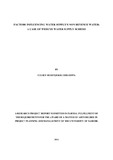| dc.description.abstract | Consumer participation allows for the public to take part in key decision making processes in the governance of the country, thus harnessing ownership and buy-in while ensuring a greater possibility of effectiveness of development projects and interventions. Prior to the reforms brought about by the enactment of the Water Act 2002, the water sector was characterized by inadequacy in funding of operations and infrastructural development, institutional deficiencies, poor coordination between various water departments and a disregard for the voice of the water consumer. The specific challenges experienced included; insufficient sector funding; over centralization of Authority; poor governance; conflicts in institutional mandates; a weak legal framework; poor services and a poor regard for the consumer. In a country which is categorized as water scarce and in which water coverage levels stand at 55 percent and sewerage coverage at an even more dismal 15 percent, complaints, dissatisfaction and concerns of inadequacy and inequity in access to water services are bound to come up. This is especially true for the poor, who occupy approximately 2000 Low Income Areas (LIAs) with an estimated population of close to 8 million. Community groups made up of volunteers who are active and passionate about water issues within their communities were selected to act as water user representatives in the grassroots through a project known as the Water Action Groups (WAGs). The WAGs were established by WASREB to act as a mechanism for redress through which water consumers can channel their complaints to the regulator and to provide both top-down and bottom-up feedback to the public and the regulator respectively. They also disseminate relevant information to the public while engaging with relevant water sector institutions for the benefit of water users. However, fluctuations in the performance of the WAGs and effectiveness in the execution of their mandate since conception, has led to the need to investigate which of five key factors have the greatest influence on consumer participation through these groups. The factors to be investigated include: funding, institutional goodwill, Information Technology, M&E and incentives. The study has reviewed a vast number of scholarly literature from published authors to provide a theoretical framework to support the research. A descriptive survey research design was applied for this research study while employing the use of questionnaires as the main data collection instrument. The target population for the study consisted of WAG members from four selected water utilities including: Nairobi, Nakuru, Eldoret and Mombasa water companies. Both primary and secondary data was collected through the use of questionnaires and through the electronic platform known as MajiVoice respectively. Data collected from the respondents was analyzed through descriptive statistics and frequencies through the use of Microsoft Excel programme and SPSS where applicable. The findings of the study showed that there is a significant positive relation between the adequacy of funds provided and the level of consumer participation through executed community participation activities. Further to this, the WSBs showed the least support and institutional goodwill towards the WAGs, while IT though thought of as useful, has not been fully exploited and is still not fully embraced by the public in the water sector. Incentives were found to have a very big influence on the motivation to continue in consumer participation although non-monetary incentives need to be exploited further | en_US |





